DISPARITY OF INCOME IN THE DEVELOPING WORLD
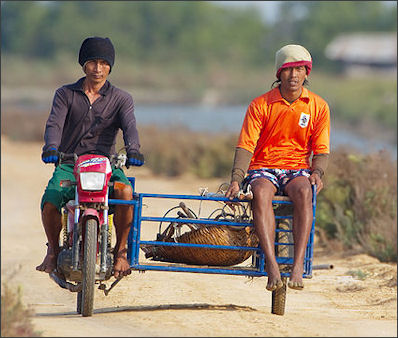
Salt farmers in Pakistan Developing world counties are generally two-tiered societies with a large, poor underclass and a small upper class, often connected with the government. The middle class is often small. In some counties, up to two percent of landowners own 65 percent of the farmland, while about a third of the plots of land cultivated by the rural poor are too small to support a family.
Between 1950 and 1970 the rich got richer and the poor got poorer. In 1950 the wealthiest 5 percent received 48 percent of the developing world's wealth while the poorest 50 percent took in only 9 percent. By 1977 the richest 5 percent received 60 percent of the wealth and the poorest 50 percent received only 7 percent. The figures are generally even more skewed today.
Middle income countries have an average per capita income far below that of the richest countries of Europe and North America but well above the poorest countries. These countries traditionally have a two-tiered society with a rich majority of landowners and industrialists and a poor minority of peasant farmers and urban shanty dwellers. They have a larger middle class than developing countries.
Income disparity is often linked to tribe, region or ethnic group. In some places, society us ruled by a dominant ethnic group.
There is also a lot of disparity in the disparity figures
Rich and Middle Class in the Developing World
The rich in developing countries often have a lifestyle similar to the rich in Western countries except they live more sheltered lives. They drive around in Mercedes, BMWs, and fancy four wheel drive vehicles. Some have private planes. But they often live behind high walls toped with broken glass and spikes and are protected by expensive security system and armed guards.
Even though they live in poor countries where many things are cheap, middle class people have to spend more to enjoy things middle class people in the West take for granted because many of the goods that define middle class status are imported, heavily taxed and expensive.
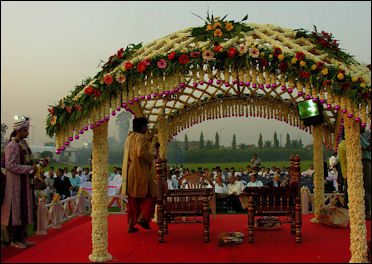
Tent for fancy Hindu wedding Dominique Moisi, a French intellectual, wrote, “In rapidly growing emerging-market countries, the rich tend to close their eyes to the suffering of the poorest, except when they feel threatened by the risk of political upheaval, as in, say, Saudi Arabia. In fact, wealthy elites in emerging countries live in a state of denial towards their poor, literally ignoring them. Brazil and India are particularly striking in this regard. Economic growth is necessary, but not sufficient: a strong sense of social responsibility is needed as well. [Source: Dominique Moisi, August 29, 2011]
Members of the middle class in developing countries are often people like a nurses, professors, small business owners or civil servant who earn around $100 a month. Homes and apartments in the affluent urban or suburban areas are furnished like homes and apartments in the West.Upper middle class people can often afford private medical care, private schools, servants and chauffeurs.
Without a middle class as a moderating force, society remains intrinsically feudal and democracy has a hard time taking root.
Poverty and the Poor in the Developing World
According to United Nations statistics a billion people don’t have access to drinking water; a billion people suffer from hunger; nearly one million people die each year of malaria, 1.3 million of tuberculosis, and 2 million of AIDS; and poverty keeps some 72 million children out of school and prevents them from realizing their potential.
There are three degrees of poverty: 1) extreme, or absolute, poverty defined by the World Bank as a household that gets by on less than $1 a day, not enough to support the basic needs of survival; 2) moderate poverty, defined as living on $1 or $2 a day, where basis need are met but just barely; and 3) relative poverty, as defined by income below a certain level of the national average.
The yardstick for extreme poverty was upped from $1 a day to $1.25 a day in 2008. With that number it is estimate that there are 1.4 billion people living under the poverty line — a quarter of the developing world. This is less than 1.5 billion in 1981. Asia has the largest number of people living in extreme poverty but Africa has the largest proportion: nearly half the population. Another three billion people or so live on less than $2 a day.

Jeffrey Sachs of Columbia University described the extreme poor as people who “are chronically hungry unable to get health care, lack safe drinking water and sanitation, cannot afford education for their children and perhaps lack rudimentary shelter — a roof to keep rain out of the hut — and basic articles of clothing, like shoes.”
At major international gatherings like the World Economic Forum in Davos, Switzerland the world’s poorest poor are increasing being referred to as the “bottom billion.” To show sympathy for and solidarity with these people the head of the Food and Agriculture Organization has called for global day of fasting.
See Food Crisis
The “poverty penalty” is a phenomena in which the poor can pay up to 25 times more certain services such as clean water as the rich.
People who have nothing are often very hospitable, generous and willing to share what little they have with guests. It often seems that poorer villagers are the more they are willing to give. "People here help one another," one villagers said. "If someone has no food one day, others share. It makes life bearable."
Travelers from wealthy foreign countries are often invited for dinner are honored with special dishes and treats that cost the equivalent of several weeks earnings. One adventurer who traveled to many countries on horseback said, once we left Europe, "we never had to buy a meal...villagers always fed us." On bicycle trips through the developing world, I found myself constantly being waved to from the side of the road for tea and food.
Rural Poor in the Developing World
About 70 percent of the world’s poor live in rural areas and depend on agriculture to making a living and feed their families. Most of the crops are raised for food. Meager surpluses or rice or potatoes or animals are sold for money. The head of the household and other family members often have no other job. It is not uncommon for a family to earn less than six dollars a month.
Many people live in mud huts with a thatch or tin roof held on with rocks and subsist off a daily rations of flour and sugar, supplemented with tomatoes and yoghurt. They cook their meals over dung fires and gather their water down stream from village privies. The wells from which water is fetched are often dry. Cigarettes are a luxury they can't afford. Wood is in short supply.
Urban Poor in the Developing World
Currently about 1 billion people live in slums and shanty towns worldwide. The population of the world’s slums is expected to double to 2 billion in 2035.
Housing, water, sanitation, power and jobs are all in short supply in the developing world’s cities. Many of the urban poor are from the countryside. The informal economy is key to a lifestyle described as “informal survivalism.” Developing the informal economy is seen as key to providing jobs and services. In some places authorities have no real presence and people are left to fend for themselves and gangsters are in control.
What looks like a miserable life to people in the developed world — a low-paying job in a textile factory and home in a shanty town — can actually be alright to the people experiencing it. People living in these circumstances appreciate having a cooking stove, cell phone, television. Their meager pay allows them to buy a few things and gives them with the opportunity to provide education for their children and at least get as far as the first rung out of poverty.
Refugees
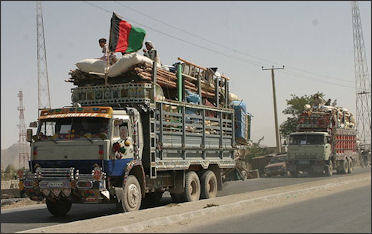
Afghan refugees returning from Pakistan in 2004 There are more than 33 million refugees and internally displaced people worldwide. The United Nations Refugee Convention defines refugees as people “who are outside their country and cannot return owing to a well-founded fear of persecution because of their race, religion, nationality, political opinion or membership of a particular social group.” The number of refugees worldwide fell from 18 million in 1992 and 12.1 million refugees in 2001 to 9.6 million in 2006.
Internally displaced refugees are denied the protection and aid given normal refugees because they have not crossed any borders. Their plights is often covered up in the media by their governments. According to the United Nations there were 25 million internally displaced refugees in 2003, almost twice the number of true refugees. About 13 million internally displaced refugees were counted in 2006.
The main refugee body is the United Nations High Commission on Refugees (UNHCR). According to a report by the UNHCR 20.8 million people were displaced by conflict or persecution in 2005, up from 19.8 million in 2004, with the increase made mainly of people fleeing Iraq, Somalia and Darfur, Sudan. Only 8.4 million were refugees that fled their country. This is the lowest figure since 1980. An addition 6.6 million have been internally displaced. The rest are either stateless asylum seekers or those who have returned home but remain under the concern of the UNHRC.
In recent years many refugees have returned to their homes in Afghanistan, Liberia, Iraq and Angola.
In refugee camps, the young and the old are the often first to die. Hungry refugees are given high energy biscuits.
See Failed States and Stateless People Under Goverment
Reducing Poverty
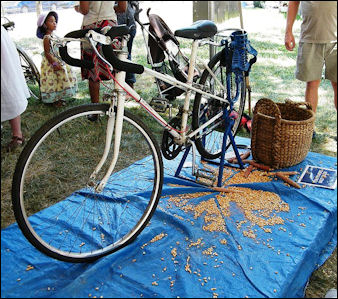
peanut butter bike The number of people living on $1 a day plummeted from 40 percent in 1981 to 18 percent in 2004 and is expected to drop to 10 percent by 2015. Poverty is on track to be cut by half between 2005 and 2015. Many of those no longer counted as extremely poor will be moderately poor, earning between $1 and $2 a day.
Wealthy nations and international organizations such as the World Bank spend more than $55 billion annually on programs aimed at helping the poor mostly in developing countries. Every year there are highly publicized meetings in which donor countries pledge billions to help countries in need.
The development approach in developing world has largely taken place in two phases: first halting population growth, reducing disease and raising literacy and second introducing skill training, technology development and export economies. Traditionally aid agencies have tended to fund rural projects — such as digging wells, building schools and planting trees — rather than urban ones.
Many experts believe that the developing world's environmental and economic problems can only be fixed by tackling by addressing social problems first. Also, something that aid workers have learned through experience is that large, big money projects shoved down local people’s throats often don’t work or cause as much harm as good while small projects, worked out with the involvement of local people are more successful.
See Foreign Aid, Humanitarianism and Development
United Nations: Number of Hungry People Declines
In September 2011, the U.N. agencies said the number of chronically hungry people in the world dipped considerably below the 1 billion mark — the first drop in 15 years — thanks partly to a fall in food prices after spikes that sparked rioting a few years ago. Still, an estimated 925 million people are undernourished worldwide, and the latest figures don't reflect the repercussions from the massive flooding in Pakistan. [Source: Frances D'emilio, Associated Press, September 14, 2010]
Frances D'emilio of Associated Press wrote: “The Rome-based Food and Agriculture Organization's report suggested some progress in the battle to end hunger, but stressed the world is far from achieving the U.N. promoted Millennium Development Goal of halving the proportion of undernourished people from 20 percent in 1990-92 to 10 percent in 2015. The report estimated there are 98 million fewer chronically hungry people than in 2009, when the figure just topped 1 billion.
U.N. officials announcing the figures said that 1,800 calories per day is considered the minimum energy intake on average. Anyone regularly without that intake would be considered undernourished, or "chronically hungry." The drop in the chronically hungry is partly because food prices have fallen from peaks in 2007-2008, when they sparked violence in several developing countries, and because cereal and rice harvests have been strong.Cereal production this year was the third-highest ever recorded, despite a drought-fueled wheat shortfall in Russia, said FAO director-general Jacques Diouf.
The drop below the 1 billion mark also reflects progress China and India have made in feeding their own. Still, those two nations, with their huge populations, account for 40 percent of the world's undernourished people. Overall, two-thirds of the chronically undernourished live in either China, India, Bangladesh, Indonesia, Pakistan, the Democratic Republic of Congo or Ethiopia, the report said. The flooding in Pakistan is also a variable that could affect future numbers. The floods have affected millions and robbed farmers of crops about to be harvested, next season's farmland and much seed.
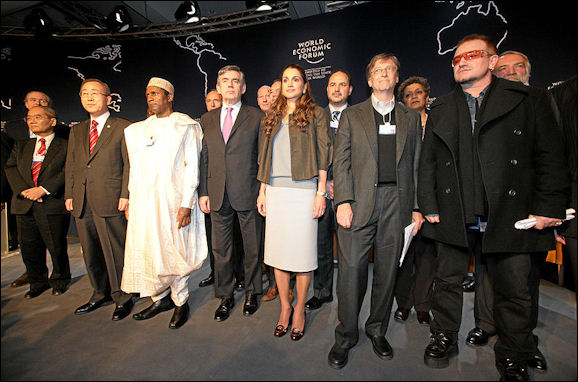
Millennium Development Goals World Economic Forum Annual Meeting Davos 2008
While welcoming the dip in the number of hungry, the non-governmental aid agency Oxfam attributed the improvement largely "to luck" and not to a change in policies or increased investment "needed to address the underlying causes in hunger." "There simply isn't enough agriculture investment today," added Yukiko Omura, vice president of the International Fund for Agricultural Development, a U.N. agency that emphasizes helping small-scale farming in developing countries.
Social Problems in the Developing World
Domestic violence is a problem in the developing world. One doctor who treated villagers said that three fourths of all the females treated for injuries at his hospital were beaten by their spouses. In some places, if a man dies in an accident or even from natural causes his wife is blamed for the death and ostracized by her village even if she had nothing to do with it.
In some places, a husband who kills his wife for committing adultery is regarded as having done the honorable thing while a man can only be penalized for adultery if his mistress is living within the family house and even then he is often only given a light sentence. Women who strike back at the unfaithful husbands are sometimes looked upon with contempt because they didn't turn a blind eye to their transgressions as they are expected to do.
Drunkenness is also a problem. It is not unusual to see drunks drooling all over themselves on buses or lying face down in the dirt streets. Young people in the slums often turn to glue sniffing.
China is the home of the 56 percent of the world's female suicides. The rate of suicides for females in China is 33.5 per 100,000 compared to 7.1 per 100,000 in the rest of the world. The rate is particularly high among rural women between the ages of 15 and 39. Women kill themselves at double the rate of men. In most countries the suicide rate is much higher men among than women.
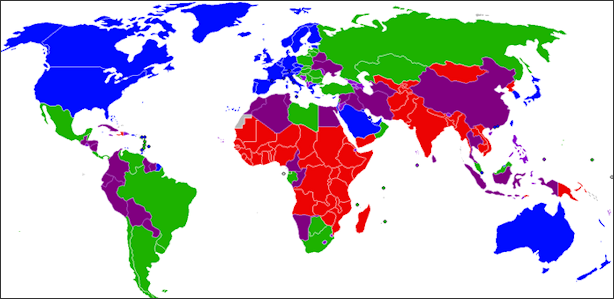
World Bank income groups
Suicide is the leading cause of death for rural women in China. Some end up as nameless and unclaimed bodies that are fished out the Yellow River and then thrown back in because nobody has claimed them. About three times as many rural women kills themselves as urban women. Most rural women and 58 percent of all women who attempt suicide ingest liquid pesticide. Pesticides are favored because they are readily available, cheap and effective. Some pesticides are so strong that a couple of tablespoons can kill a person in two hours.
Image Sources: Wikimedia Commons
Text Sources: New York Times, Washington Post, Los Angeles Times, Times of London, Yomiuri Shimbun, The Guardian, National Geographic, The New Yorker, Time, Newsweek, Reuters, AP, Lonely Planet Guides, Compton’s Encyclopedia and various books and other publications.
Last updated January 2012
